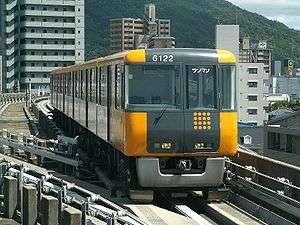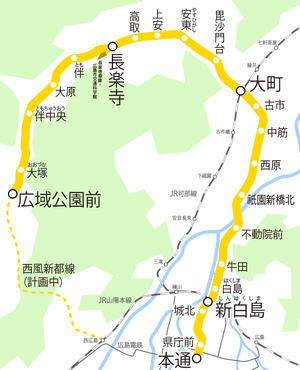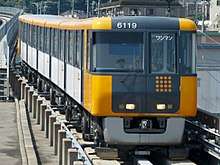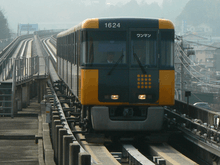Astram Line
Hiroshima New Transit Line 1 (広島新交通1号線, Hiroshima Shin Kōtsū 1-gō-sen), also known as the Astram Line (アストラムライン, Asutoramurain), is a rubber-tired transit system operated by Hiroshima Rapid Transit in Hiroshima, Japan. Astram opened August 20, 1994 for the 1994 Asian Games in Hiroshima. The line connects central Hiroshima and Hiroshima Big Arch, which was the main stadium of the Asian Games. On March 14, 2015, a new station, Shin-Hakushima, opened to make a new connection between the Astram Line and JR lines.
| Astram Line (Hiroshima Rapid Transit Line 1) | |||
|---|---|---|---|
 A 6000 series train on the Astram Line in July 2007 | |||
| Overview | |||
| Type | Automated guideway transit | ||
| Locale | Hiroshima | ||
| Termini | Hondōri Kōiki-kōen-mae | ||
| Stations | 22 | ||
| Operation | |||
| Opened | August 20, 1994 | ||
| Owner | Hiroshima Rapid Transit | ||
| Depot(s) | Chōrakuji | ||
| Technical | |||
| Line length | 18.4 km (11.4 mi) | ||
| Number of tracks | 2 | ||
| Electrification | 750 V DC third rail | ||
| |||
Stations
| Station | Japanese | Distance (km) | Transfers | Location |
|---|---|---|---|---|
| Hondōri | 本通 | 0.0 | ■ Hiroden Ujina Line (at Hondori) | Naka-ku |
| Kenchō-mae | 県庁前 | 0.3 | ||
| Jōhoku | 城北 | 1.4 | ||
| Shin-Hakushima | 新白島 | 1.7 | ||
| Hakushima | 白島 | 2.1 | ||
| Ushita | 牛田 | 2.9 | Higashi-ku | |
| Fudōin-mae | 不動院前 | 4.0 | ||
| Gion-shinbashi-kita | 祇園新橋北 | 5.0 | Asaminami-ku | |
| Nishihara | 西原 | 6.0 | ||
| Nakasuji | 中筋 | 7.0 | ||
| Furuichi | 古市 | 7.8 | ||
| Ōmachi | 大町 | 8.4 | B Kabe Line | |
| Bishamondai | 毘沙門台 | 9.6 | ||
| Yasuhigashi | 安東 | 10.6 | ||
| Kamiyasu | 上安 | 11.4 | ||
| Takatori | 高取 | 12.0 | ||
| Chōrakuji | 長楽寺 | 12.7 | ||
| Tomo | 伴 | 13.9 | ||
| Ōbara | 大原 | 14.9 | ||
| Tomo-chūō | 伴中央 | 16.0 | ||
| Ōzuka | 大塚 | 17.6 | ||
| Kōiki-kōen-mae | 広域公園前 | 18.4 |
Rolling stock
- 6000 series 6-car EMUs (23 sets)
- 1000 series 6-car EMU (1 set)
- 7000 series 6-car EMUs (11 sets on order)
As of 1 April 2016, services on the line are operated using a fleet of 23 six-car 6000 series trainsets (sets 01 to 23) and one six-car 1000 series (set 24).[1]
The entire fleet of 24 sets is scheduled to be replaced with a new fleet of six-car trains delivered in two batches. The first of 11 new 7000 series sets was delivered in 2019.[2] They are scheduled to enter service in March 2020.[3]
History
Plans to build a new transit system linking the city centre of Hiroshima with the suburban area to the northwest were first proposed in July 1977.[4]
The third-sector Hiroshima Rapid Transit was founded in 1987, funded primarily by the city of Hiroshima.[4] Groundbreaking for the rapid transit line project began on February 28, 1989, and construction would continue over a five-year period. However, on March 14, 1991, 15 people were killed when a girder collapsed on a section of the line's elevated viaduct near the Kamiyasu station's construction site. The line opened for revenue service on August 20, 1994.[4]
When the line originally opened in 1994, it had 21 stations, of which Ōmachi provided the line's only transfer with a JR West line (the Kabe Line). On March 14, 2015, Shin-Hakushima opened as an infill station between Hakushima and Jōhoku in order to provide a transfer point with the Sanyo Main Line.
See also
- List of rapid transit systems
References
- 私鉄車両編成表 2016 [Private Railway Rolling Stock Formations - 2016] (in Japanese). Japan: Kotsu Shimbunsha. 25 July 2016. p. 171. ISBN 978-4-330-70116-5.
- "Hiroshima rubber-tyred light metro train delivered". railwaygazette.com/metro-report. DVV Media International. 11 October 2019. Archived from the original on 11 October 2019. Retrieved 28 December 2019.
- "広島高速交通,7000系を報道陣に公開" [Hiroshima Rapid Transit, 7000 series released to reporters]. Japan Railfan Magazine Online (in Japanese). Japan: Koyusha Co., Ltd. 11 October 2019. Archived from the original on 7 December 2019. Retrieved 28 December 2019.
- Terada, Hirokazu (19 January 2013). データブック日本の私鉄 [Databook: Japan's Private Railways] (in Japanese). Japan: Neko Publishing. p. 166. ISBN 978-4-7770-1336-4.
External links
| Wikimedia Commons has media related to Astram Line. |
- Official website (in Japanese)
- Map of Hiroshima rail transit network


